On the same day that Bank of Canada governor Stephen Poloz was in Vancouver speaking about monetary policy, federal Finance Minister Bill Morneau last week was updating his 2016 budget with a commitment of an additional $81 billion in capital works spending over the next decade.
What the two presentations had in common is that, to a great extent, both take long-term views for managing Canada’s economy as it enters a new era of slow global economic growth.
The Chinese supercycle that drove unprecedented demand for commodities has cooled, the baby boomer generation is entering its sunset years, the energy sector is in transition, and developed economies are simply going to have to get used to slower growth and do whatever they can to boost productivity and workforce numbers.
The slower growth in developed economies may seem surprising, given the explosion in innovation and technology that has given rise to companies like Google, Apple, Amazon and Tesla.
“Even though there might be good productivity, we are in for a slower growth scenario than what we got used to, and that’s primarily a demographic thing,” Poloz said at the November 1 BC Business Summit.
Although global economic growth is expected to pick up, improving from 2.8% in 2016 to an estimated 3.5% in 2018, the longer-term trend is for slower growth.
For the last two years, Canada’s gross domestic product grew about 1%, thanks in no small part to the oil price shock and wildfires that have ravaged Alberta’s economy. Even when Canada’s economy gets back to firing on all cylinders, its real GDP growth “speed limit” is projected to be 1.5%, says Jock Finlayson, chief policy officer for the Business Council of BC, which hosted last week’s summit.
Concerns over the long-term decline in population and productivity in developed economies explains why the federal government wants to boost immigration, has been aggressively pursuing international trade agreements and plans to spend an additional $81 billion over the next 12 years on infrastructure.
“It’s basically taking a really long-run view,” Allan Maslove, research professor at the School of Public Policy and Administration at Carleton University, said of last week’s federal budget update. “It’s not really promising anything that’s going to change very much in the next two to three years.”
Finlayson agrees: “The vast majority of this infrastructure plan over 12 years, and the increase of $81 billion, the bulk of that is actually back-loaded into the 2021 to 2028 period. So it will make very little difference to growth and employment in the short term.”
The federal government plans to spend $180 billion over the coming 12 years on key areas like public transit, trade and transportation networks and “green” infrastructure.
To help raise some of the capital needed, Ottawa plans to create a new infrastructure investment bank that will leverage private-sector investment, notably from pension funds. But its spending plans commit the government to years of deficit spending.
“Clearly the Trudeau government has moved off the mantra of balancing the budget as the most important thing for the national government to do,” Finlayson said. “We don’t have a major problem with that because the Canadian economy has taken some big hits over the past two to three years through the oil price collapse and downturn in business investment.”
Commodity prices have been moving back up and exports are also increasing. Canadian exporters could benefit significantly from CETA (Comprehensive Economic and Trade Agreement), which Canada and the European Union recently signed.
However, that may just increase Canada’s share of a shrinking pie. Overall, developed economies will continue to slow in growth, thanks to aging populations.
To address a workforce shrinkage, the updated federal budget includes a “global skills strategy” to attract skilled workers from outside of Canada.
As for monetary policies, the Bank of Canada plans to hold a steady course by sticking with its key policy – inflation targeting. While addressing Business Council of BC members last week, Poloz admitted the central bank has wrestled with the question of whether that policy tool has become ineffective with overuse.
Despite the best attempts to stimulate economic growth in the U.S., Japan and Europe through measures like quantitative easing and low, zero or even negative interest rates, economic recoveries have been weaker than expected.
That has led the Bank of Canada to ask whether inflation targeting and low interest rates need rethinking.
“But to date, we have not seen convincing evidence that there is an approach that is better than our inflation targets,” Poloz said.
Harkening back to the 1970s and 1980s, when inflation spiked to 12%, and mortgage rates soared to 20%, Poloz said variable and unpredictable inflation is “deadly for confidence.”
“It is a source of uncertainty that would be brutal in today’s economic climate,” he said.
The central bank recently renewed its inflation target for five years, which aims to keep inflation within 2%.
The low interest rate environment that comes with that policy has prevented many businesses from investing, because they want higher returns on their investments. Poloz suggested they need to “re-calibrate” their expectations.
“When I hear stories of companies and boards insisting that anything we do has to give us at least 10%, what I think is they’re going to end up not having opportunities,” he said. “Someone else is just going to buy that opportunity from under them – someone that understands this and is willing to take, say, a 5% return on equity instead of insisting on a much higher number.
“As we get older, I think 5% is going to sound like a really strong number.”




